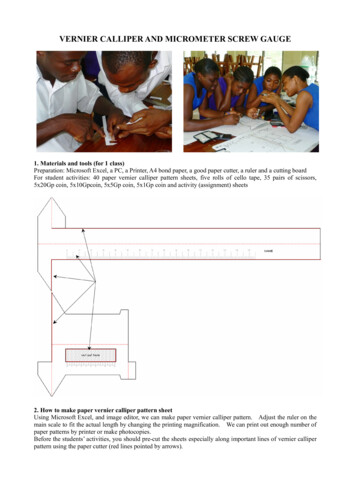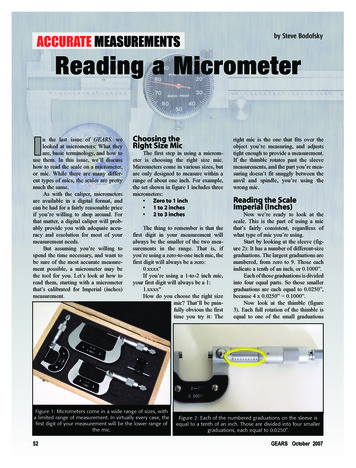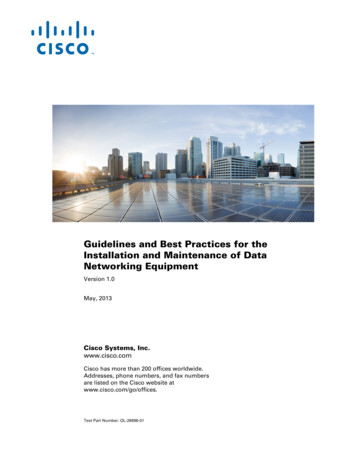
Transcription
VERNIER CALLIPER AND MICROMETER SCREW GAUGE1. Materials and tools (for 1 class)Preparation: Microsoft Excel, a PC, a Printer, A4 bond paper, a good paper cutter, a ruler and a cutting boardFor student activities: 40 paper vernier calliper pattern sheets, five rolls of cello tape, 35 pairs of scissors,5x20Gp coin, 5x10Gpcoin, 5x5Gp coin, 5x1Gp coin and activity (assignment) sheets2. How to make paper vernier calliper pattern sheetUsing Microsoft Excel, and image editor, we can make paper vernier calliper pattern. Adjust the ruler on themain scale to fit the actual length by changing the printing magnification. We can print out enough number ofpaper patterns by printer or make photocopies.Before the students’ activities, you should pre-cut the sheets especially along important lines of vernier calliperpattern using the paper cutter (red lines pointed by arrows).
PRACTICAL USE OF MEASURING INSTRUMENTS 21. How to read vernier scale1). Relation between the main scale and the vernier scaleThe vernier scale is divided into a certain number of divisions (n,e.g. 10, 20).The total length of whichcorresponds to the length of (n-1, e.g. 9, 19, 39) of the smallest main scale divisions. Then “v” is the length ofvernier scale division, and “s” the length of the smallest main scale division. We have.nv (n-1)se.g. n 10, v 9/10mm, n-1 9 and s 1mms-v s/nexampledifference between “s” and “v” is s/n: e.g. s 1mm, v 9/10mm and s/n 1/10 mmn 10, v 9/10 mm, s 1 mm2). Measurement samplePoint “x” lies between 31.0mm and 32.0mm on the main scale. We must find vernier scale line whichcoincides with a main scale line.In this example, the sixth line coincides with a main scale line.3). CalculationThe length (l) from original point to point “x” is calculated as follows.The length of the main sale division is 1mm. Therefore, distance “a” on main scale from 32.0mm line to37.0mm line is 5mm.37.0mm – 32.0mm 5.0mmThe length of vernier scale division is 9/10mm. Therefore, the distance “b” on vernier scale from point “x”to sixth line is 5.4mm9/10 mm x 6 5.4mmDistance “b” is 5.4mm – 5.0mm longer than distance “a”. Then we have the length (l) like this.32mm- (5.4mm – 5.0mm) 31.6mm・・・length (l)
2. Make your paper vernier calliper1) Make paper vernier calliper using the pattern sheet, a pair of scissors (or a cutter, a metal ruler and acutting board) and cello tape.2) Cut out the pattern sheet along black lines as fairy as possible. I recommend cutting along inner side ofthe width of black lines. Fold the papers along dotted red lines in order to make printed side outside.The most important foldings are the jaw parts. Do them carefully.3)Close “the outside calliper jaws” and read the vernier scale. If your vernier scale 0 line aligns with themain scale 0 line, your paper vernier calliper is perfect. If it shows bigger than zero, you should deductthe length from actual measuring result. Check the vernier scale line from left end and find a linewhich aligns with a main scale line. Read and record the amount which is shown on aligned vernierscale. If it shows between 2 and 3, it means 0.25mm.3. Sample measurement using paper vernier calliperCheck table of the “sample result of measurement”. When you measure diameters of coins, you mustmeasure an object rotating 0 , 60 and 120 . Next figure shows the diameter of the object is 17.45mm5Gp coinSample Result of MeasurementRotate 0 Rotate 60 Rotate 120 Zero error0.25mm0.25mm0.25mmMeasurement value18.35mm18.30mm18.25mmCalibrated result18.10mm18.05mm18.00mmCalibrated result Result with “Zero Error” subtractedAverage18.05mm
4. Micrometer screw gauze (Quoted from “Wikipedia” and other websites)1) Parts2) How to read micrometerThe spindle of an ordinary metric micrometer has 2 threads per millimetre, and thus one complete revolutionmoves the spindle through a distance of 0.5 millimetre. The longitudinal line on the frame is graduated with 1millimetre divisions and 0.5 millimetre subdivisions. The thimble has 50 graduations, each being 0.01millimetre (one-hundredth of a millimetre). Thus, the reading is given by the number of millimetre divisionsvisible on the scale of the sleeve plus the particular division on the thimble which coincides with the axial lineon the sleeve.Suppose that the thimble were screwed out so that graduation 5, and one additional 0.5 subdivision were visible(as shown in the image), and that graduation 28 on the thimble coincided with the axial line on the sleeve. Thereading then would be 5.00 0.5 0.28 5.78 mm.3) Torque repeatability via torque-limiting ratchets or sleevesAn additional feature of many micrometers is the inclusion of a torque-limiting device on the thimble—either aspring-loaded ratchet or a friction sleeve. Normally, one could use the mechanical advantage of the screw toforce the micrometer to squeeze the material or tighten the screw threads, giving an inaccurate measurement.However, by attaching a thimble that will ratchet or friction slip at a certain torque, the micrometer will notcontinue to advance once sufficient resistance is encountered. This results in greater accuracy and repeatabilityof measurements—most especially for low-skilled or semi-skilled workers, who may not have developed thelight, consistent touch of a skilled user.4) Testing and calibrationThe accuracy of micrometers is checked by using them to measure gauge blocks, rods, or similar standardswhose lengths are precisely and accurately known. If the gauge block is known to be 0.7500" ( .00005"), thenthe micrometer should measure it as 0.7500". If the micrometer measures 0.7516", then it is out of calibration.The accuracy of the gauge blocks themselves is traceable through a chain of comparisons back to a masterstandard, such as are maintained in measurement standards laboratories.
PRACTICAL USE OF MEASURING INSTRUMENTS 2Group:Class:Date:Names of group member (fill in block letters)Index numberFirst nameMiddle nameMeasurement 1: measure diameters of coinsResult of MeasurementRotate 0 Rotate 60 1 Gp coinLast nameRotate 120 Zero errormmmmmmMeasurement valuemmmmmmCalibrated resultmmmmmm5 Gp coinRotate 0 Rotate 60 Rotate 120 Zero errormmmmmmMeasurement valuemmmmmmCalibrated resultmmmmmm10 Gp coinRotate 0 Rotate 60 Rotate 120 Zero errormmmmmmMeasurement valuemmmmmmCalibrated resultmmmmmmMeasurement 2: measure thickness of the centre of coins and clip wiresResult of MeasurementCoin 1Coin 2Coin 31 Gp coinmmmmmmMeasurement valuemmmmmmCalibrated resultmmmmmmCoin 1Coin 2Coin 3mmmmmmMeasurement valuemmmmmmCalibrated resultmmmmmmClip 1Clip 2AveragemmAveragemmmmAverageZero errorPaper clipmmAverageZero error5 Gp coinAverageClip 3mmAverageZero errormmmmmmMeasurement valuemmmmmmCalibrated resultmmmmmmmm
VERNIER CALLIPER AND MICROMETER SCREW GAUGE 1. Materials and tools (for 1 class) Preparation: Microsoft Excel, a PC, a Printer, A4 bond paper, a good paper cutter, a ruler and a cutting board For student activities: 40 paper vernier calliper pattern sheets, five rolls of cello tape, 35 pairs of scissors, 5x20Gp coin, 5x10Gpcoin, 5x5Gp coin, 5x1Gp coin and activity (assignment) sheets 2. How











